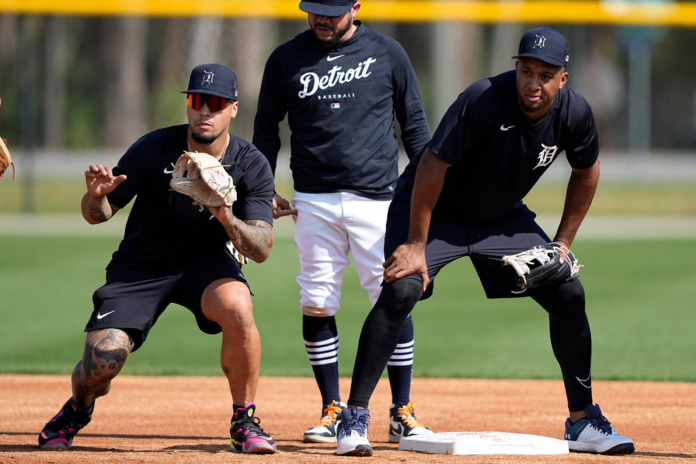MLB MLB curtails infield shift, hopes for more singles, speed The league hopes to fix the significant batting average drop seen over the last few seasons. Detroit Tigers infielders Javier Baez, left, and Jonathan Schoop, right, work on drills at second base during a spring training baseball workout Sunday, Feb. 19, 2023, in Lakeland, Fla. (AP Photo/David J. Phillip) AP
PHOENIX (AP) — Milwaukee manager Craig Counsell needed to add some pop to his lineup a couple years ago, so he put a few more big bodies in his four-man infield, sacrificing defensive range for offensive thump.
“They combined for a weight of over 1,000 pounds,” Counsell said, laughing.
“I don’t think you’ll ever see that again.”
There’s little doubt that hiding a couple bulky sluggers in the infield is going to be more challenging this season. One of Major League Baseball’s most visible rule changes for 2023 is a limitation on infield shifts, which had grown exponentially and are partly to blame for a league-wide batting average drop.
Advertisement:
The hope is twofold: One, a few more hits for lefty mashers like Kyle Schwarber or Corey Seager, who were among those hindered by the shift. And two, stress on athleticism and range for those playing defense in the infield.
“I’m sure some guys will like it and some won’t,” said former Red Sox second baseman Dustin Pedroia, a four-time Gold Glove winner. “You’ve got to have range now as an infielder. Got to be able to catch the ball. You’ve got to be quick.
“It’ll be an adjustment for some guys. It’ll make other guys better.”
Hitters in the big leagues had a .243 batting average last season, the lowest since 1968.
The new rule states that all four infielders must have both feet within the outer boundary of the infield and two infielders must be on each side of second base when a pitch is delivered. MLB also mandated infield dirt have uniform dimensions in all 30 ballparks — the outfield edge must be 95 feet from the front of the pitching rubber.
A few hitters — notably New York Mets star Jeff McNeil — adapted to exploit the gaping holes in the infield shifts with hard-hit balls the other way. Most stuck to their modern, pull-heavy approaches, in part because pitchers strategized to make going to the opposite field difficult — even big league hitters struggle to slap an up-and-in 98 mph fastball the other way.
Advertisement:
Arizona’s Josh Rojas, a left-hander hitter, said he wasn’t particularly worried about the changes. He views them as just the latest salvo in ongoing pitcher-vs.-hitter battle that’s ebbed and flowed for more than a century.
“The holes will be in different spots,” Rojas said. “My goal as a hitter is to find the holes and use those to my advantage. There are always holes — you can’t cover every single one on the field.”
Enterprising teams spent the offseason peppering the commissioner’s office with questions about ways to potentially circumvent the guidelines.
Morgan Sword, an MLB executive vice president, said teams primarily had three questions:
— Can an infielder be put in motion during the pitch, running toward the other side of the diamond, so that there are three infielders on one side of second base once the ball is put in play? (The answer is no.)
— Can an infielder be put in motion during the pitch, running toward the outfield grass, so that he’s in the outfield by the time the ball is put in play? (No)
— Can teams move outfielders around, such as the left fielder moving into short right field for a lefty pull hitter, leaving left field unmanned? (Yes)
Advertisement:
Umpires have broad discretion to enforce the guidelines.
“They’ll know if a team is trying to break the spirit of the rule,” Sword said.
MLB’s hope is shift limits will add a hit or two each night. Not only will the shift affect batting, but it makes speed and agility more important for infielders, who must cover more ground on defense.
“Those are the demands. You have to pick up the baseball and also hit it,” Arizona manager Torey Lovullo said. “We’re not just going to put someone in one spot, stand on the ‘X’, we don’t believe in that. We do have very athletic position players.”
The shift limit has been tested in the minor leagues, and Lovullo said that after speaking with the organization’s Double-A manager, Shawn Roof, he expects offense to jump.
“He said it makes a difference,” Lovullo said. “There are more balls getting through.”
The change could affect some pitchers, too. D-backs right-hander Merrill Kelly said he’s been told advanced metrics say he’s been one of the beneficiaries of the shift.
But the veteran, slated to pitch for the U.S. in the World Baseball Classic, is fine with the new rules.
“I’m a fan of taking away from the shift, even though statistics say that I could benefit from it,” Kelly said. “I think hits should be hits and outs should be outs.”
___
AP freelance writer Ken Powtak contributed to this report.


